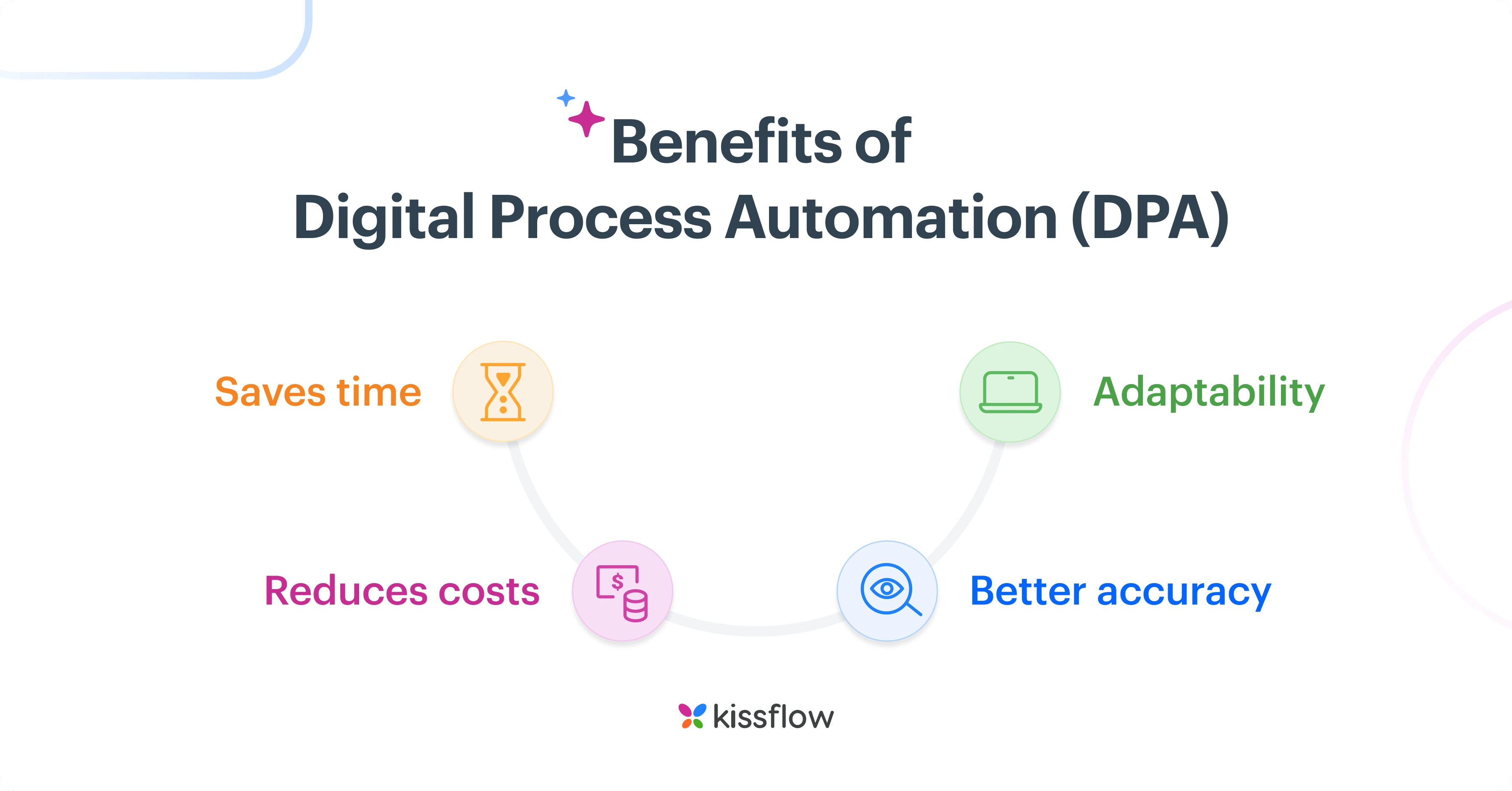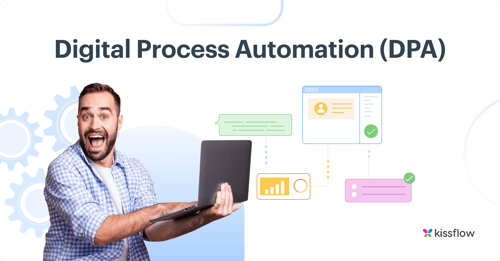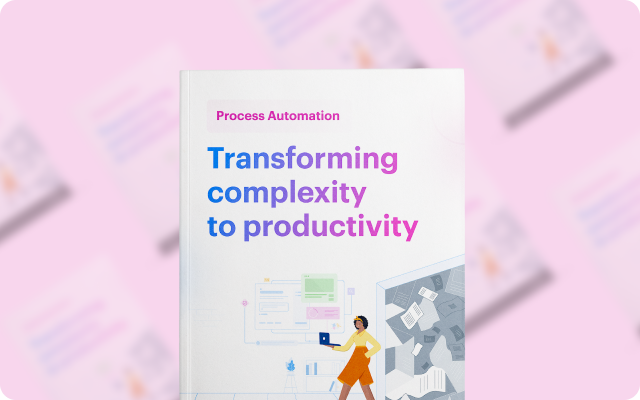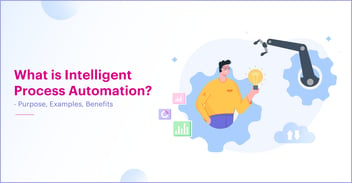Leading enterprises are focused on continually digitizing their operations to become more customer-centric and responsive–both in terms of how they meet evolving customer demands and introduce new products to the market.
CIOs strategizing their organization’s digital journey are leveraging Digital Process Automation (DPA) to rapidly automate business processes and streamline workflow management.
DPA is a crucial evolution of longstanding business process management (BPM). It can digitize key processes and enable free flow of information across the organization.
What is Digital Process Automation (DPA)?
Digital process automation (DPA) is defined as the process of using advanced digital tools like low-code development solutions to create, automate, and optimize business operations. The purpose of digital process automation is to eliminate human intervention in business processes so that the workforce can focus on more value-adding tasks.

Some of the key principles of digital process automation include:
- Maintaining transparency across processes
- Automating customer tasks
- Triggering notifications and reminders
- Creating an easily collaborative atmosphere
When do I need digital process automation?
With digital process automation, companies are able to become more customer-focused and responsive. As their operating model becomes digitized and intelligent with digital process automation, it also becomes possible to take more risks with product innovation.
After all, we live in a digital age where the culture of rapid experimentation is crucial for all businesses. Automation that cuts across organizations, people, and processes helps enable that approach.
For instance, if a new product has been rapidly launched by the company and digital process automation metrics reveal that it is widely successful with customers, then the product can be quickly scaled to increase the overall revenue of the company.
Similarly, if the same product is unsuccessful in gaining customer adoption, then it can be killed quickly without causing too many losses.
The shift from BPM to digital process automation
Organizations across numerous industries heavily rely on business process management (BPM) to streamline their business processes and manage overall costs.
With the overall costs already decreased through efficient BPM tools, the next step for organizations is to enhance customer experience–which is where digital process automation (DPA) comes into play.
Apart from offering the traditional BPM features like process compliance, cost reduction, and seamless management of processes, digital process automation also supports a large number of business-driven applications that put focus on customer outcomes.
Clearly, the need to drive digital transformation initiatives and improved customer experience has evolved and shifted the BPM market towards digital process automation.
Therefore, organizations that still haven’t incorporated digital process automation, would have to accelerate their digital transformation steps and find the right way to incorporate digital process automation in order to stay relevant and get ahead of their competition.
Examples of Digital Process Automation
Most business processes that involve human interaction with external users can benefit from DPA. They can be digitized and automated to enhance user experience. Here are some digital process automation examples in real business scenarios:
1. Customer Onboarding
Manual onboarding requires collecting a lot of information, processing documentation, setting up trainings or orientations, and other processes. When the entire onboarding experience is drawn out, customers can get frustrated.
To prevent this, a business organization can use DPA to automate most of the steps in the onboarding process. It removes bottlenecks in the workflows and facilitates faster and more efficient transitions between each step. It also ensures that information is always accurate and up-to-date.
2. Loan and Credit Approval
Loan and credit approval is among the business processes that can greatly benefit from DPA. Gathering documentation and assessing the creditworthiness of a client is a daunting task that requires much time and effort when done manually.
With DPA, the lending process is automated and streamlined to ensure greater efficiency, accuracy, compliance, and timely approval. Automated credit scoring enables lending institutions to process a larger volume of loan applications while automated credit monitoring allows them to check the financial health of their borrowers.
The benefits of DPA in loan and credit approval extend to the customers of the lending institutions. As the approval process becomes more efficient, loan applications are processed faster while borrowers get the best deals possible.
3. Purchase Orders
Purchase orders are repetitive and recurring processes that business organizations deal with on a regular basis. They often require several approvals, causing delays and affecting productivity. With DPA, transitions between approvals can be streamlined for speed. Once a purchase order is submitted for approval, the DPA software automatically routes the request to the appropriate personnel. It also automatically notifies the requesting individual once an action is taken. This significantly reduces the time wasted going through revisions otherwise done manually.
4. Transportation and Logistics
Logistic companies are among those with the most time and labor-intensive business processes. Generating and collecting invoices, scheduling, and tracking shipments, securing proofs of delivery, resolving payment disputes—all these repetitive processes take unnecessary time when done manually. Moreover, they are prone to errors and inefficiencies that can result in huge losses.
DPA can reduce these inefficiencies and optimize processes to enhance the customer experience. DPA not only streamlines workflows but also improves the visibility of order and shipment status. Ultimately, it improves business growth and helps build better customer relationships.
Benefits Digital Process Automation (DPA)

1. Saves time
By automating hundreds, and even thousands of manual repetitive tasks in your organization, you are able to save precious time of your employees which allows them to focus on more important core tasks.
3. Reduces costs
Human labor is expensive. When you automate processes, you also improve employee effectiveness and contribute towards financial savings of your organization that can have a big effect on the company’s bottom line.
4. Better accuracy
Digital process automation is able to achieve better accuracy in processes by eliminating situations where the documents may be displaced or process steps might be missed.
5. Adaptability
By implementing digital process automation, organizations are able to quickly launch and scale new solutions according to the needs of the market
Features in digital process automation software
Digital process automation (DPA) tools help companies create completely automated process solutions. With the right digital process automation tool, you are able to seamlessly build applications to manage processes and digital workflow.
Ideal digital process automation software should be able to:
- Offer robotic and automation capabilities
- Incorporate some level of intelligent automation
- Provide low code workflow and application development features
- Include an intuitive and visual interface that does not require any technical expertise to operate
Choosing the right digital process automation tool can make all the difference
Kissflow is a low-code development platform with a visual drag-and-drop editor that allows you to automate business processes in your organization and develop applications efficiently. Both developers and business users can build complex workflows and automate repetitive parts of the process with minimal to no coding.
It takes less than 15 minutes to create and automate a workflow on Kissflow. Try it today!













